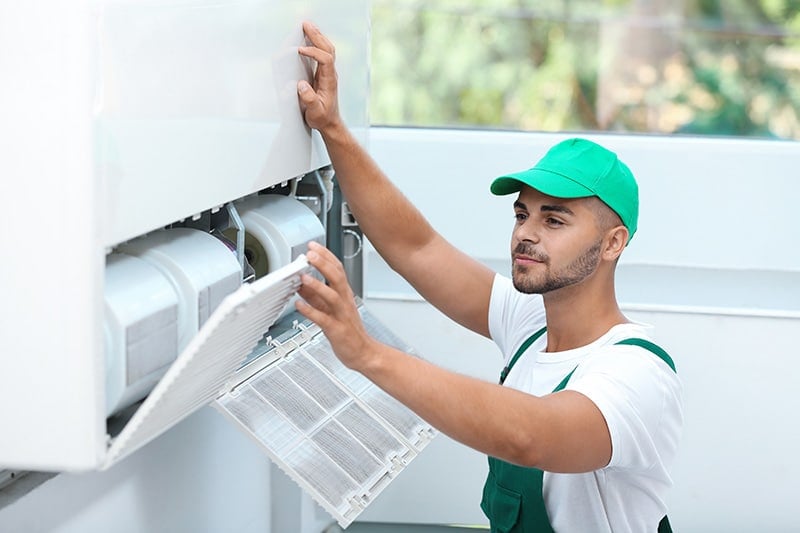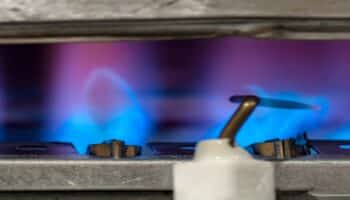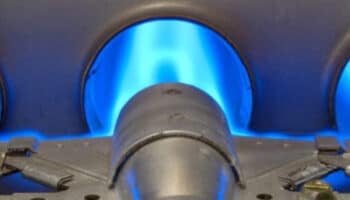Is your furnace short-cycling?
That sucks! I know how frustrating it can be when your furnace is experiencing issues, especially during winter.
But don’t worry. I’m here to help.
If your furnace keeps turning on and off, the air filter is probably dirty and needs to be cleaned or replaced. Inspecting the thermostat, flame sensor, and flue is also important. Don’t forget to check the size of the furnace.
Read on to get your furnace working again!
Preventing Your Furnace From Short-Cycling: 5 Steps
It is normal for furnaces to turn on and off. When your thermostat detects the room temperature is lower than the desired setting, the furnace turns on to warm the space. Once it reaches the desired temperature, it automatically turns off.
However, if your furnace turns on and off too frequently, it indicates a problem with one of its components.
Don’t worry, though. In this section, I’ll walk you through five different solutions you can try to prevent your furnace from constantly cycling on and off.
Are you ready? Let’s get started!
#1 Replace the Air Filter
I find that when a furnace keeps turning on and off, it’s typically due to a clogged air filter.
Your furnace’s air filter is responsible for trapping dust, pet hair, and other contaminants that could affect air quality.
Unfortunately, when the filter becomes clogged, it obstructs the airflow, which can cause the furnace to overheat. As a result, the unit will shut off to prevent safety hazards.
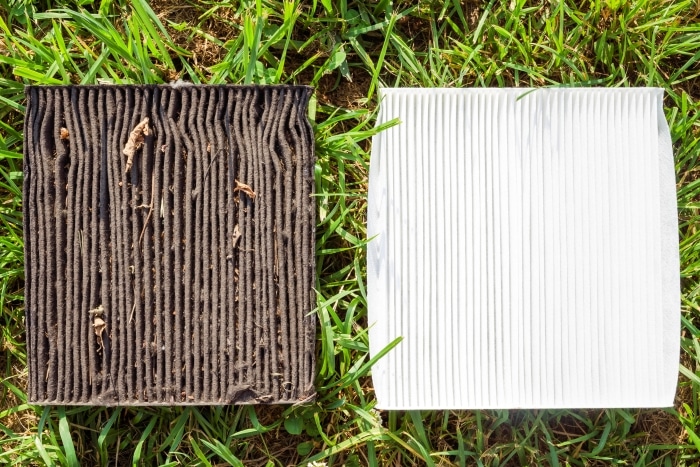
Don’t worry, though. Cleaning or replacing your furnace’s air filter is very simple. You’ll just need to:
- Turn off your furnace and find the filter, which is typically located near the fan or return air duct. Keep in mind that the exact location of the filter will vary depending on your furnace’s model. You can locate your filter by clicking here or referring to the owner’s manual.
- Once you’ve located the filter, gently slide it out of its compartment.
- Use an old toothbrush or vacuum to remove dust, dirt, and other debris. You can also rinse the filter with water. Don’t forget to let it dry completely before reattaching it to prevent mold growth.
- If the filter is very dirty or has been used for more than three months, replace it with a new, compatible one.
- Slide the clean or new filter back into its compartment. Ensure that you install the filter with the arrows pointing in the direction of airflow, which is usually indicated on the filter.
Once you’ve cleaned (or replaced) the air filter, please turn your furnace back on. If it’s still short-cycling, there’s likely an issue with the thermostat. Read on to learn how to fix it.
#2 Inspect the Thermostat
In my experience, a faulty thermostat can also explain why your furnace is short-cycling.
You see, the thermostat is responsible for monitoring the room temperature and signaling the furnace to turn on or off to reach the desired setting. If the thermostat is faulty, it will fail to read the actual temperature in your home, causing the furnace to turn on and off.
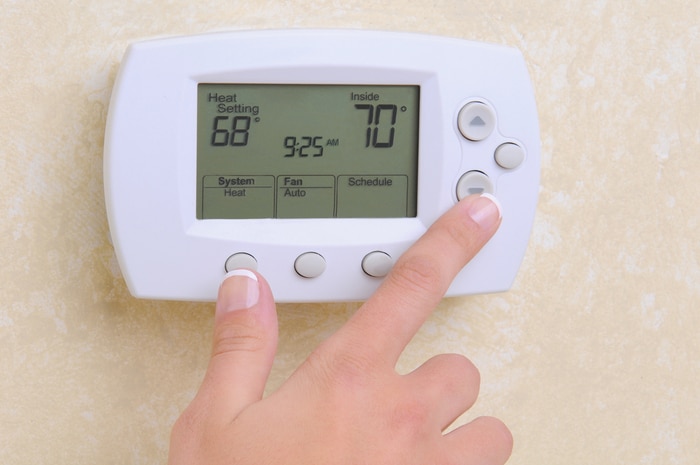
To rule out the thermostat as our possible culprit, please locate it and double-check the settings. Ensure it’s set to the right mode and temperature.
If your thermostat’s display is dark, try replacing the batteries with fresh ones and checking the circuit breaker. If the circuit that supplies power to the thermostat has tripped, you should reset it.
However, if the issue persists, consider replacing the thermostat. Here’s how to do it:
- Turn off the power at the circuit breaker to prevent electrical hazards.
- Carefully undo any screws holding the front protective panel in place.
- Take a picture of the wiring connections.
- Disconnect the wires from the old thermostat and remove the mounting plate from the wall.
- Secure the new mounting plate and connect the wires to the new thermostat. Remember to consult the manufacturer’s manual.
- Place the front protective cover in place and restore power. Then, test the thermostat by adjusting the temperature.
Note: Make sure your thermostat is away from direct sunlight, lamps, drafts, or other factors that could cause inaccurate readings.
Keep in mind that if you’re uncomfortable testing or replacing the thermostat yourself, it’s best to call an appliance repair expert.
#3 Clean the Flame Sensor
From what I’ve seen, a dirty or faulty flame sensor can cause a gas furnace to turn on and off.
The flame sensor is responsible for detecting the presence of the flame when the gas furnace is running. If the sensor is malfunctioning or covered in dirt or soot, it won’t recognize the flame, leading to the shutdown of the gas valve as a safety measure.
Follow these simple instructions to clean the flame sensor.
- Turn off the power to the furnace to prevent electrical hazards. It’s also important to switch off the gas supply.
- Remove the panel to access the flame sensor. Keep in mind that you’ll need to use a screwdriver.
- Locate the flame sensor, which has a metal rod with a white porcelain insulator and a single wire attached.
- Remove the screw that holds the flame sensor in place. You should only touch the porcelain part of the flame sensor.
- Use fine steel wool to clean the flame sensor gently. Be careful not to scrub the sensor excessively to prevent damage.
- While cleaning the sensor, look for any visible signs of damage or significant wear. If you notice the flame sensor is damaged, you must get a replacement.
- Place the sensor back in its bracket and secure it with the screws you previously removed.
Once you’ve cleaned or replaced the flame sensor, restore power and gas to your furnace and test the unit.
#4 Examine the Flue
If your furnace keeps short-cycling, I recommend checking the flue.
The flue is a duct or pipe responsible for venting harmful gases out of your home. If it becomes clogged, your furnace will shut down to prevent carbon monoxide and other gases from entering your living space.
Please turn off the furnace and check the exterior cover. Sometimes, birds and other small animals build their nest right there.
You can also use a flashlight to look inside the flue. If you notice any obstructions, try using a long brush to clear them. Additionally, it’s important to use a vacuum to clean out the base of the flue.
If you’re not an experienced DIYer, my usual advice is to contact an HVAC professional to inspect the flue for any damage that could be causing the issue.
#5 Check the Size of the Furnace
If you’ve tried all the fixes mentioned above, but your furnace keeps turning on and off frequently, it’s likely because it’s too large for your space.
An oversized furnace can generate excessive heat in a short time, causing the unit to shut off quickly. Since the furnace runs briefly, the heat dissipates rapidly, leading to the short-cycling issue.
If your furnace is oversized, you’ll notice increased energy bills, temperature fluctuations, and quicker wear and tear on the unit’s components.
Unfortunately, if your furnace is oversized, the best solution is to replace it with one that matches the heating requirements of your space.
Wrapping Up: Stop Your Furnace From Short-Cycling
That about covers it! Hopefully, now you know how to fix your furnace’s short-cycling problems.
Remember that if your furnace keeps turning on and off, you’ll need to clean or replace the air filter, check the thermostat, and clean the flame sensor. If the issue persists, don’t forget to examine the flue and check the size of your furnace.
Thank you so much for taking the time to read this guide. If you’ve found it helpful, please check out our other related articles.
Good luck!


